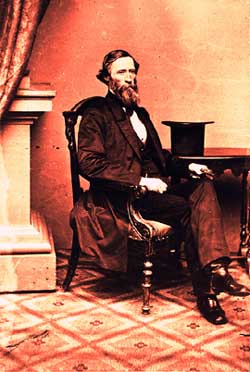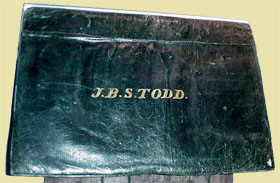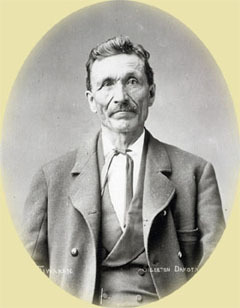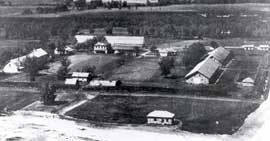|
Lesson 1
John B. S. Todd and Gabriel Renville
|
| |
In 1850, few white people lived in South Dakota. The grassy prairies
went on for miles. They had never been plowed. Only Sioux (Dakota,
Lakota, and Nakota) Indians and fur traders lived here. To others,
it was the
frontier.
|
|
|
|
John B. S. Todd and the Making of Dakota Territory
|
|
|
|
John B. S. Todd came to Dakota in 1855. He was a soldier with
General William S. Harney. Todd liked what he saw here. He started a
trading post. He sold supplies to soldiers at Fort Randall. Todd’s
company was named Frost, Todd and Company.
|
|
Todd saw that he could make
more money if there were farms on the prairie. First, the Indians
had to say it was okay for people to live in Dakota. Todd helped
the Yankton Nakotas negotiate a treaty (you learned about this in
Unit 4). The treaty opened part of eastern South Dakota to
American settlers. The land was between the Big Sioux River and
the Missouri River. Todd’s company bought some of the land. Then
he sold it to farmers. He also started the town of Yankton.
He sold town lots to people who wanted to start a business.
|

Photo courtesy of South Dakota State
Historical Society
|
|
|
|
Todd wanted more people to buy land. More settlers would come if the
land were part of the United States. First it had to be a territory.
Todd got settlers to sign a paper. The paper asked the government to
make Dakota Territory. Todd was the cousin of Mary Todd Lincoln. She
was the wife of President Abraham Lincoln. This relationship may
have been why the president was willing to talk to Congress. He
asked them to make Dakota Territory. The year was 1861. Todd went to
Washington, D.C., to talk for the settlers. He also helped to make
Yankton the capital.
|
|

Photo courtesy of South Dakota State
Historical Society
|
Later Todd went back to the army for awhile. He was a general during
the Civil War. Afterwards he came back to Yankton. He was elected to
the territorial legislature. Todd died at Yankton in 1872.
|
|
|
|
Gabriel Renville and Fort Sisseton
|
|
|
|
|
Life changed for the Indians. Once they had moved freely. They had
followed the buffalo and the changing seasons. Now they had to stay
on reservations. The Indians had to
adapt to a new lifestyle.
They needed strong leaders to help them.
Gabriel Renville was born on the shores of Big Stone Lake. It
was about 1824. His father was a French and Sisseton Dakota fur
trader. His mother was of Dakota and British
ancestry. When
he grew up, Gabriel Renville would work hard to keep his Dakota
people together.
|

Photo courtesy of South Dakota State
Historical Society
|
|
|
The Dakotas, or eastern Sioux, lived on reservations in Minnesota
first. They were not happy there. Some of them left the reservation
(you read about this in Unit 4). Many settlers were killed. Renville
and his band did not join the fighting. Instead, they helped white
people get away from the raiding Dakotas. The raiders then burned
the homes of Renville and his people. They were left with "no
lands, no homes, no means of support."
The United States government was thankful for what Renville and
his people had done. The government made Renville an army
scout.
Other men in Renville’s band were also scouts. It was a way to
support themselves.
|
|

Photo courtesy of South Dakota State
Historical Society
|
Four years later, Renville became head of the Sisseton-Wahpeton
Sioux Tribe. He signed the treaty that set up Lake Traverse
Indian Reservation. This was in northern Dakota Territory.
Renville became chief of scouts at Fort Sisseton. He taught
his people new skills. He taught them how to farm. He taught them to
take care of themselves in a white man’s world. He led his people
until his death in 1892.
|
|
|
|
| Vocabulary |
|
| adapt (v.), to
adjust or change to fit something new
ancestry
(n.), the people from whom one comes;
forefathers and foremothers
|
frontier (n.), the region just beyond or at the edge of
a settled area
scout (n.), a person sent out from a larger group to
gather information
|
|